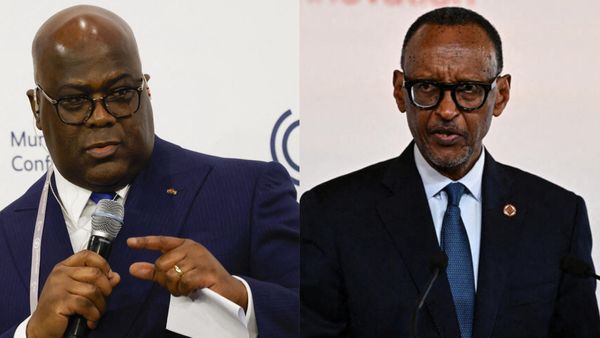
Alex Lynn had just taken pole position and yet wasn’t confident of converting top spot in qualifying into victory at the Sao Paulo 6 Hours.
“A podium will be a good result,” he reckoned. What could be interpreted as pessimism turned out to be misplaced. Come the end of Sunday’s race, the Briton and Jota Cadillac team-mates Will Stevens and Norman Nato were celebrating a first World Endurance Championship victory for the American marque at the head of a 1-2.
What changed in the 24 hours or so from qualifying to the midpoint of the race, when it became clear that the Cadillac V-Series.R LMDh was the dominant car around Interlagos?
Firstly, the Caddy was even better in race conditions than Lynn and his team-mates were hoping for. Secondly, the Porsche 963 LMDh, the car they’d been expecting to have an edge, wasn’t on point.
The Caddy looked after its tyres, the medium Michelin that was the predominant compound used during the Brazilian race, better than the Porsche. The winning #12 car in particular had a clear advantage over the final 10 or 15 laps of a double stint.
So good was the winning Caddy that its drivers were able to come back from a first-hour penalty to take the lead of the race early in hour three when Lynn got the jump on Jenson Button in the #38 Jota Caddy shared with Earl Bamber and Sebastien Bourdais. By the end of that hour they pretty much had one hand on the winners’ trophy in Brazil. Put simply, the #12 was in a class of its own.

“Being totally honest, I don’t think we expected to be as good as we were,” said Lynn. “The car was sensational. We knew it was good from practice, but that good? No. Even at the end when Norman jumped out, he said, ‘Man, I didn’t change anything on the settings because it was so good’.”
The drivers of the second-placed Jota Caddy didn’t feel quite the same way about their V-Series.R at the weekend. They struggled to nail the balance through practice, swapping to the set-up of the sister car for third free practice to no avail and then reverting to their original path for qualifying. They ended up with a much softer car than their team-mates on the other side of the garage.
The #38 was good enough for Bourdais to qualify second, though he started third after a penalty for an on-track infraction, and to keep the eventual winners honest, at least for the first four hours of the race. But over the final couple of stints Bourdais struggled. A gap that had stood at little more than 20s before he took over went up to 57s by the chequered flag.
"Was it because we were softer and stopped energising the tyres in the right way? I’m not sure. Definitely traffic was not good for me when I came out of the pits and I kept getting traffic in really bad places, but the car didn’t feel good at all" Sebastien Bourdais
Such were his struggles that he came under pressure from the best of the factory Penske Porsches right at the end of a race. Julien Andlauer got the gap down to under a second, but wasn’t able to take a serious look at the Cadillac and followed it over the line 1.8s in arrears.
Bourdais wasn’t entirely sure what went wrong. “Was it because we were softer and stopped energising the tyres in the right way? I’m not sure,” he mused. “Definitely traffic was not good for me when I came out of the pits and I kept getting traffic in really bad places, but the car didn’t feel good at all. I just tried to hold the fort.”
The Porsche, which Andlauer shared with Michael Christensen, undoubtedly picked up pace at the end. The cooler temperatures, similar to those at the start when Andlauer had led the way ahead of the Caddys, certainly played a part in the pressure Bourdais came under at the end.

Yet Porsche conceded that it didn’t have anything for Cadillac over the full duration of the race. “Our tyres were diving,” said Porsche LMDh programme manager Urs Kuratle. “You could see that in the middle of the race.”
Jota had to think on its feet with its tyre strategy. The early penalty for Stevens, a drive-through, was called because the rear tyres were under the minimum mandated pressure. He pitted out of second after 30 laps and was back in for an early first service just five laps later. Jota didn’t really have a choice but to bring Stevens back in.
“We were back out on under pressured tyres and we didn’t know how long we had before we got another penalty,” explained team boss Sam Hignett. Stevens had to take four new tyres rather than the planned two, so when Lynn took over shortly before the end of hour two, he got fresh rubber on the hard-used right side only.
His stop came six laps before Bamber, who’d taken the lead from Andlauer just after Stevens came in, and he handed over to Button. Lynn got the undercut on the 2009 Formula 1 world champion, who’d been given four new tyres. Button with a full set of new Michelins was able to bring down a deficit that originally stood at 15s to under 10s, before Lynn eased it back out after it was his turn to get four fresh tyres and Button two.
No one else was in the game round the 2.68-mile Interlagos circuit. The second Porsche Penske Motorsport entry driven by Laurens Vanthoor and Kevin Estre ended up fourth, albeit a lap down on the leader. It all went wrong for the #6 crew when Estre, so often the king of qualifying for Porsche, could only put his car seventh on the grid. It took them nearly three hours to clear the two Peugeot 9X8 Le Mans Hypercars, the prodigious straightline speed of the French machines making them difficult to pass.
And that was that in terms of cars that had, or might have had, a chance of leaving Brazil with some silverware. Peugeot looked on course for a double top-six finish until the #20 BMW M Hybrid V8 shared by Sheldon van der Linde, Rene Rast and Marco Wittmann overhauled them both in the final hour to take fifth. It jumped the #93 car driven by Paul di Resta and Mikkel Jensen in the pits before van der Linde overtook Loic Duval on track in the sister car shared with Malthe Jakobsen with nine laps to go.

Ferrari, unbeaten in the WEC this year prior to the South American leg, and Toyota, which dominated at Interlagos in 2024, were nowhere. The 2025 system of Balance of Performance based on race averages from the previous events (which may or may not now be two rather than the three at the start of the season) hurt the Ferrari 499P LMH around a track at which it didn’t perform last year. It was a kind of double whammy: bad BoP, bad track.
Toyota’s GR010 HYBRID LMH had gained weight and lost power since last year — 9kg but more crucially 28bhp — and the abrasive Interlagos track surface that played a part in its domination was a thing of the past. The circuit was resurfaced ahead of last year’s Brazilian Grand Prix in November.
The results were predictable once the BoP table for Brazil had been published on the Monday ahead of the race. That said, no one could have said that Cadillac was going to dominate in the way it did. Not even Jota and its drivers
Ferrari went home with a best finish of eighth for the Le Mans 24 Hours-winning crew of Robert Kubica, Phil Hanson and Yifei Ye in the satellite AF Corse entry. The factory car of Nicklas Nielsen, Antonio Fuoco and Miguel Molina ended up 12th behind team-mates Alessandro Pier Guidi, James Calado and Antonio Giovinazzi but should have been higher. Ferrari reckoned it could have finished between the Peugeots, but for a clash with an LMGT3 Chevrolet Corvette that damaged the rear bodywork. Race control demanded it pit for repairs, which resulted in an extra stop and no way back.
The Toyotas trailed home 14th and 15th, Kamui Kobayashi, Mike Conway and Nyck de Vries heading Brendon Hartley and Ryo Hirakawa. They were both three laps down at the chequered flag, not that Toyota Gazoo Racing Europe technical director David Floury seemed particularly surprised.
He reckoned the results were predictable once the BoP table for Brazil had been published on the Monday ahead of the race. That said, no one could have said that Cadillac was going to dominate in the way it did. Not even Jota and its drivers.








